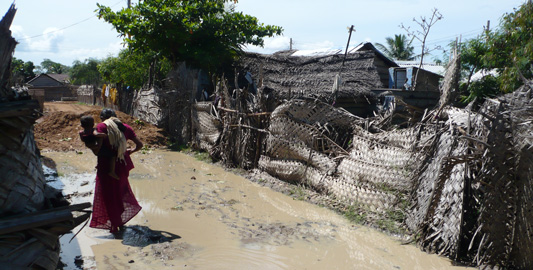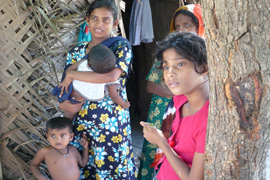Caught in the middle
Displaced Muslim refugees see hopes of repatriation dashed due to renewed fighting.

 |
| In the Soltan camp, outside Puttalam, the monsoon rains have already flooded much of it |
With the Sri Lankan government formally ending a 2002 Norwegian-brokered ceasefire with the Liberation Tigers of Tamil Elam (LTTE) on January 16, the hopes for repatriation of refugees displaced by the fighting have faded.
In the north-western town of Puttalam, home to thousands of Sri Lanka’s Northern Muslims, this is a particular source of despair.
After 17 years of their flight from the Northern provinces, which became defacto battlegrounds between the LTTE and government forces, many of these refugees still live in squalid camps.
In the Soltan camp, located in a depression outside Puttalam, the monsoon rains have already flooded much of it. In the dry season, it becomes a dust bowl.
Samsiya, a mother of seven who fled Jaffna and has been living at the camp, said: “There is diarrhoea, malaria – look, there is water everywhere, full of mosquitoes.”
A.M. Mihlar Mohammed, programme director with the Community Trust Fund, which works with the Puttalam refugees, said that 80 per cent of the Internally Displaced People (IDPs) live in such camps and rely on aid.
“The government fixed aid at 1260 rupees ($11) per family per month back in the 1990s and it has not gone up [since]. Think about it – a small packet of dried milk now costs 280 rupees,” he said.
The government says that it is trying to do its best for the refugees at a time when its resources are greatly stretched. In 2007 it appealed to the Kuwait Fund and other international donors to help in the construction of new housing facilities for the displaced.
Battleground displacement
In November 1990, some 80,000 Muslims from Sri Lanka’s northern provinces were given as little as two 48 hour periods by the LTTE to vacate their homes.
“They made the announcement over the mosque loudspeakers,” recalls S. Marhana from Jaffna. She now lives with 116 other families in the IDP camp at Soltan.
 |
| Some 80,000 Muslim IDPs seek a return to Sri Lanka’s northern provinces |
Back then, the LTTE controlled a swathe of territory from Jaffna at the very northern tip of the island to Mannar and Vavuniya further south.
Most of the LTTE’s supporters are from among the ethnic Tamil, largely Hindu community which forms a minority on an island with a largely Buddhist Sinhalese majority. Sri Lanka’s Muslims, who are mostly Tamil-speaking, form a minority within this ethnic group.
Asan Saleem, whose family was expelled from Mannar by the LTTE, said: “They had a responsibility to look after us. After all, they were saying that the Sinhalese majority on the island did not look after them. Then they went and did the same thing to us.”
Forced from their homes, most had then to walk on foot through the jungle to government-controlled areas.
“Some disappeared,” recalls K.M. Ashar, also from Mannar. “Many families still don’t know what happened to their relatives. It was the richer ones particularly who vanished.”
Many of the refugees were relocated to Puttalam. The population of this coastal community doubled, placing a huge stress on local resources – a burden which continues to this day.
Looking for answers
Meanwhile, many IDPs feel that after 17 years, the LTTE has still offered no good explanation for what many Muslims say was a programme of ethnic cleansing.
“We still don’t know why they did this,” says Saleem.
“We had always got on well with other Tamils before. For the ethnic cleansing though, the LTTE brought in people from outside the area to carry it out. Some of the other Tamils protested too, particularly the local Christian priests, who tried to stop us being expelled. But they couldn’t stop it.”
However, after the ceasefire agreement with the government had been signed in 2002, the LTTE admitted that the expulsions had been a “political blunder”.
In 2003, representatives of the Sri Lanka Muslim Congress, the country’s main Muslim political party, met Velupillai Prabakaran, the LTTE chief, who urged the Muslims to return to the areas they had been expelled from.
An agreement was signed to facilitate this but was never implemented.
Military solution favoured
Muslims say chances for their repatriation will brighten if the government and LTTE return to the negotiating table and halt all hostilities.
But that now seems a distant hope. Since fighting broke out again in April last year after the 2002 ceasefire started crumbling, over 5,000 people have been killed.
Jehan Perera of the National Peace Council, a Colombo-based think-tank, says both sides are readying for an all-out war.
He said: “The government is now almost totally focusing on the military solution, while the LTTE’s response has also been entirely military. I think we can say with reasonable certainty that the military conflict is just going to escalate.”
No going back
Samsiya says such escalation means they will never go back home. “We are afraid to go back. In Jaffna there are killings and bombs all the time.”
M. Farooka, another Jaffna refugee, said: “Even if the army says it now controls the situation, at night the LTTE might come back, or put snipers out during the day. It is just not safe at all.”
In the camp at Soltan, the more immediate problems are the flooding and the daily question of finding enough to eat.
Saleem despairs at his community’s continuing misery.
“I think to the outside world, to our own government, and to the LTTE, we no longer exist.”